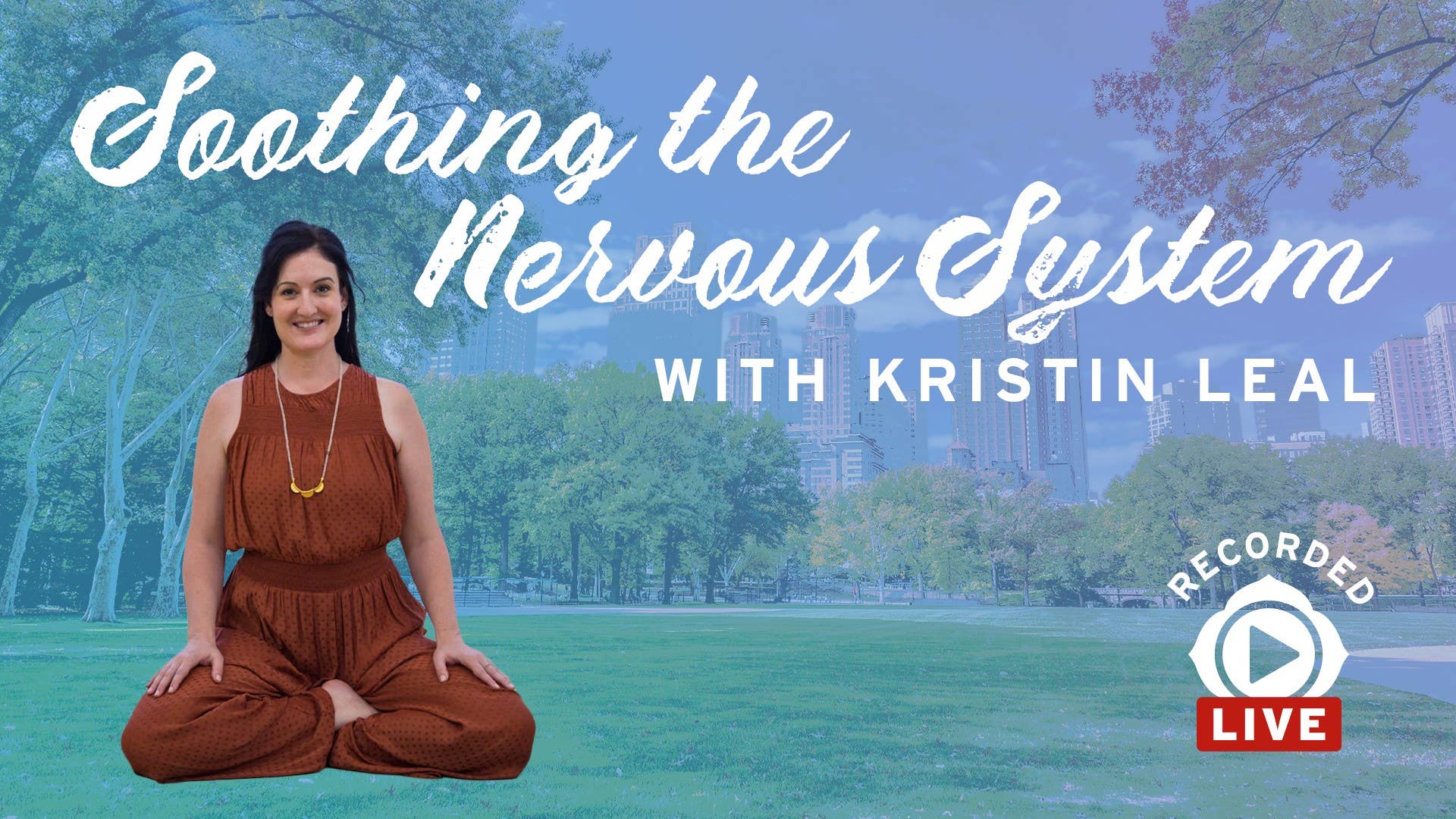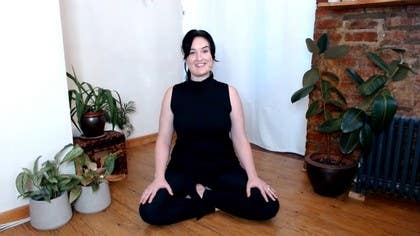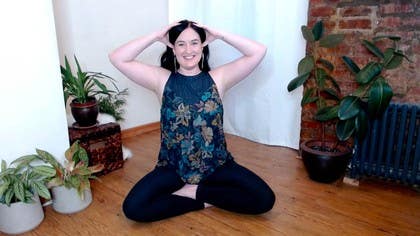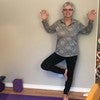Description
Cultivate a different relationship with your "fight or flight" response system. Kristin leads our Yoga Nidra practice exploring the activated state of sympathetic engagement through an illuminating body scan visualizing points of sunlight and the sound of RAM. You will feel a sense of warm, peaceful awareness.
You can follow along with the Grounding Mantras at the end of each class by accessing the PDF attached below.
About This Video
Transcript
Read Full Transcript
All right, so let's start by taking the most comfortable seat that will work for you. We will be sitting for a few minutes, so it's worth your comfort. It's worth being comfortable. So if you want to sit up on the edge of a folded blanket or a pillow, couch cushion, you can go for that, or even on the edge of your chair. If you're in a chair, have the feet flat on the floor, and make sure that you make yourself as comfortable as possible so that you can fidget a little bit less and feel a little bit more.
All right, as you're ready, you can turn your palms face down onto your knees or thighs, hug the spine up a little bit taller, and when you very much feel ready to do so, you can close your eyes. Give yourself time just to land, to feel, to acknowledge where you are in this transition into your practice, and just start to direct your attention to your breathing without having to shape it yet or exaggerate it in any yoga type of way. Just note when you're inhaling and exhaling, maybe the particular placement in the body of the breath, and there's no right answer that we're looking for here, just awareness of your breath, almost like you're taking a before picture. What tends to happen for many of us is that we carry quite a bit of tension in the shoulders, neck, throat, around the collarbones, from, let's say, life, or from using our devices or just general posture issues, which starts to choke off the very top portion of our breath and makes it a little less available to us, so let's just start by lifting your awareness up into those regions, the shoulders, neck, throat, collarbones. Even then to the jaw, the mouth, tongue, or palate.
Maybe just by drawing your own very sweet awareness, those places begin to soften on their own, maybe even just a little bit. Keeping your eyes closed, just taking one hand over the other hand over the heart center or the center of your chest, and on top of your breastbone, you can feel the beat of your heart and the movement of the breath under your hands. Just slide your hands a little bit to the right, so right underneath your right collarbone to that pectoralis flesh or breast tissue, right underneath the collarbone, and you're going to give a little press in with your hands and a little press down with your hands. So in and down, right under the right collarbone, lift the crown of your head up a little bit taller, and then just start to turn your nose to the left, so turning your head away from those hands. Keep your jaw soft and even let the jaw kind of hang for a moment, tongue falling behind the lower teeth, pressing in and down with your hands, crown is lifting, nose is turning to the left, and then if you want, keep your head where it is and just angle your chin up slightly.
You might feel a little stretch in the front of the throat, neck, maybe even top of shoulder. And then just slowly turning your head or nose back to center, slide the hands back over the breastbone, the center of your chest, feel the base of your skull lift, the chin comes in slightly, almost like you're making a, like a baby double chin, and then slide your hands over to the left chest, right underneath that left collarbone, that pec flash or top of the breast tissue, and press in with your hands with a bit of oomph and down, keep lifting the crown and then turning your nose away from the hands to the right. And then maybe even angling your chin up, it's kind of a very dramatic head and neck position. Just feeling a little opening in the front of the throat, neck, chest, you can even kind of make a chomping motion with your jaw, turning your head back to center, hands in front of the heart, lifting the head, you can release your hands back down onto your knees or thighs and let's just take some deep breaths, gradually deepening the breath in and out through the nose, and as you make that switch to a more conscious, thoughtful thought of breath, let the mind just grow curious as to where the breath unfolds, unravels, as if the breath could work you like a wet piece of clay, just carving out some more space internally. Take your time with this as your breath climbs a little bit deeper, maybe you can start to feel it tickle up underneath the collarbones, the first two ribs on either side, underneath the armpits, the shoulder heads, once the breath slowly and gradually dives a little bit deeper, maybe even feel at the height of your inhale, the collarbones kind of turn upwards into a little bit of a smile as the breath flourishes underneath them, might even be helpful that at the very height of the inhale you bring your chin just ever so slightly in that baby double chin, feeling the back of the neck lengthen, sipping in even more breath at the height of the inhale and taking your time, there's no strain needed, just an exploration. As you continue these deep breaths you may even start to feel comfortable at the very height of the inhale to just suspend the softest of suspensions at the height of the inhale, the mind just falls into the heart and of course exhaling when you need to when you're ready to. A few more times if comfortable taking a slow long kind of luxurious inhale to the very height of the inhale, the collarbones lifting the chin comes ever so slightly in maybe there's a pause, the sweetest of suspensions before you slowly exhale. Taking one or two more like this, your own pace, just an exploration, there's no need to strain or force anything here, just a little experiment with the breath.
Reaching your next breath, relax any known control of the breath, just take a few seconds to observe, whatever there is there to observe. As you're ready, bringing your chin down to your chest, allowing your eyes to flutter open, maybe just take a hazy gaze at one point on the floor to begin. As you're ready, letting your focus come back into your space, into our virtual space. Feel free to stretch your legs if you need. In the last couple of practices, we've been talking about the nervous system and basically the two big branches of the nervous system, the central nervous system and the peripheral nervous system. In our last practice, we focused quite a lot on the central nervous system, the superhighway of information of brain and spinal cord, a little visitor, brain and spinal cord or Sushumna Nadi, that center highway of intelligence. And today I'd like to, in the next couple of practices, I'd like to look at the peripheral nervous system and all of its glory. My cat is eating my notes right now. So in the peripheral nervous system, we have a few different branches for study. We have what's called the voluntary part of our nervous system. This is all the stuff that we're all probably more familiar with, like I could come and grab my cat and get him out of the way and he could not pay attention to me. And we could voluntarily leverage movement across our joints using our muscles, voluntary action. And then if it's not voluntary, it's involuntary. In the anatomy books, they definitely call it involuntary, like your heart is beating right now involuntarily, or you're digesting your last meal involuntarily or memory consolidation. All those things are happening without your conscious interference and control, thankfully. But involuntary, even though that word is correct in the anatomy books, it's not my favorite way to describe it because it sounds to me like it's involuntary. I have no interaction with it. It's all out of my control when it couldn't be further from the truth. Involuntary part of our nervous system, another word we could use is autonomic. Autonomic, autonomy, right? A law unto itself. The autonomic nervous system, yeah, it's all happening without our conscious control, but it's also extremely hackable, right? It's hacked by whatever's going on around us, right? And it's also hacked by whatever's going on inside of us. And the yogis of old created and designed and reverse engineered all of these different techniques to hack in to this autonomic nervous system to make us more masterful of the system. And that's what we're going to, I'd like to look at over the next few practices, how to become more masterful of this autonomic nervous system. The autonomic nervous system can be subdivided into two big branches. We've got sympathetic nervous system and parasympathetic nervous system. You might be more familiar with the terms when sympathetic is activated, it's called the fight or flight. Parasympathetic activation is often termed the rest and digest. But again, here is where words sometimes fail us and give us kind of the wrong idea. Sympathetic fight or flight sounds pretty negative. Like if I said, okay, which would you rather be in? Fight or flight or rest and digest? Most commonly you'd say, oh gosh, I don't want fight or flight. That sounds terrible. My job must be to turn off fight or flight, to quell it, to quash it and to only elicit the rest and digest. It gives us a kind of a bad feeling when we say that fight or flight. It is true that this part of the system evolutionarily is designed when revved up to attend to allow us to flee from a threat like a mountain lion charging at us. Of course, we want to have superhero powers in that moment to fight. Probably not your best bet with the mountain lion or flee, right? Run like the wind in the opposite direction. But we need this part of our system, the sympathetic activation, maybe not up to a 10, but we need it on a 3 or a 4. Right now I'm hoping that you're on about a 3 or a 4 in the sympathetic scale because that allows us to engage. So instead of calling it the fight or flight, I prefer to call it engagement, right? We need to engage with the world. We need to engage with our job, our families, how we move through the world. We need to have purposeful action and we need sympathetic activation. So instead of fight or flight and rest and digest, I'd rather think of it as engagement and release, right? Both are needed. And in fact, in the beauty and intelligence of how we are evolutionarily designed is to switch back and forth peacefully throughout the day. About 88 or so minutes we're in sympathetic activation. It's a little bit of transition time and then we swing peacefully into parasympathetic activation for about 88 minutes. And then we switch back to sympathetic and we go back and forth very peacefully in a perfect world. And it ain't a perfect world, but in a perfect world we kind of swing back and forth gently, right? We need access to both engagement and of course release. The problem is that we get stuck in one or the other. We get over activated, over responsive, over stimulated and often in our world sympathetic, we get stuck in sympathetic or hyper reactive and sympathetic. So a lot of the practices that I think are in the capital Y yoga practices, the big yoga practice of meditation and breathing and yoga nidra and asana is about not, is about stimulating purposefully sympathetic, right? If you've ever been in chair pose for 10 breaths, you ain't resting and digesting. You are, you are stimulating a sympathetic response, right? But hopefully your teacher's not screaming at you like, I said, bend your knees. Hopefully your teacher is saying something like, where's your breath? Where's your mind? What is the reality of this situation, right? Where are you? Tether back. And that is helping us to reframe our relationship with sympathetic, right? Because stress and sympathetic activation is part of life. You don't get out of life without stress, right? You don't get out of your day without sympathetic activation, right? You don't get out of this year without sympathetic activation. So hopefully you're retraining your relationship to that sympathetic activation or to that stress, right? So that when you're in a stressful moment, which, hello, life, we have an opportunity, we have an opportunity to develop a pause, a reflection and a moment to say, where's my breath? Where's my body? What is the reality of this situation? What is the next good step? How do I move forward from here? So reframing to that idea of stress. In fact, in anatomy language, the word stress is not actually a negative. It's how we evolve.
It's how we remodel. It's how we change. It's how we develop is stress. And the same could be thought of perhaps with how we relate to stress in our life. So it's an opportunity to remodel, to change, to evolve, and to take the next good step, right? So in yoga language, in the energy body language, sympathetic activation, engagement will have correlations with something called pingala or pingala, depending on who your teacher is. And this is the solar masculine, not gender, but as a concept, masculine, young, active, heating, solar channel, right? And so in our practice, our yoga nidra practice that we'll do right now, we'll start to move into a more solar activated state, but in a place of witnessing. So to not become over responsive and stressed, but to be able to interact with the sympathetic, to interact with the solar masculine, heated, young aspects of ourselves, of this moment, and perhaps cultivate a different relationship, a different response to it. That's the plan. So it starts by coming down onto your back and setting yourself up well for the next, what could be around 35, 40 minutes. So you want to hedge your bets, take your time, and set up in a position that you can be both warm and comfortable in. I'll stay seated as you come down. Now if practicing yoga nidra on your back is uncomfortable for you, you can do this seated, or resting on your side, or use any kind of props that help you be more comfortable. So a pillow under your knees, if you're on your back, a flat blanket under your head, if your room is particularly bright, maybe a scarf or a piece of clothing over your eyes, maybe a blanket on top of you, get cozy, and give you just a few more moments to make any adjustments that you need. All right, settling in to the practice of yoga nidra, widening your heels a little wider than hip distance apart. Maybe rotate your legs a few times in and out and in and out, letting them just kind of fall or flop to a more open position. Adjusting the buttock flesh so it feels more or less symmetrical underneath you. Letting the spine have its gorgeous curvature, no need to flatten or distort. Allowing the arms to move a little bit away from the sides of your body, turning your palms to face up. As your hands and arms relax, the fingers could just naturally curl inwards, moving your head a little side to side or up and down. Find the sweetest position for your head and neck, closing your eyes. Visualize as if you're resting somewhere beautiful, quiet. If you're on a perfectly manicured piece of land on the earth, soft. Around you, you can feel the heat or warmth of the sun shining down on you. You feel a beam of that sunshine land on your toes and the feet. You feel your toes warm. The warmth as it kisses the skin, invites the feet to soften and grow heavier into the earth below. You can feel the rays of the sun start to slowly move up the body, warming the ankles, shins and calves. Shins and calves grow heavier. Sunshine bathes the knees and the thighs and the hips. And as they feel that warmth, the legs growing more relaxed, heavier into the earth below. Feel the sun shine down on the belly and through the chest. Feel the torso growing warm and heavy. The sun shining down onto the arms and hands, fingers. The sun's warmth bathes the arms, the arms growing more relaxed. Feel the warmth of the sun on the throat and neck, the jaw, tongue, all the small muscles of the face, cheeks, forehead, ears, the muscles of the face relaxed. And then the sun felt at the crown of the head and the scalp. And the scalp relaxes, crown softens. Even allowing the breath to relax, so no need to create any special breathing. The breath just floats back to its natural and fussed with and perfect rhythm. You start to sense it beyond, beneath the breath. There's a sense of prana or energy. It's not limited to the nose or lungs or chest. It can be felt almost as like a wave in the body. You might feel it like tingly sensation, electricity. You might even see it or experience it as warmth or light. Just keeping the breath relaxed, just feel or notice that as you happen to inhale, you feel the prana moving from the toes to the crown. It's like you're watching a wave peacefully moving towards the shore. As you happen to exhale, you can feel a sense of that prana washing back down from crown down the body to the feet. As you happen to inhale, you feel it moving from the toes to the crown. As you happen to exhale, it washes back down from crown down the body to the toes. Just peacefully watching like you're watching the tides move in and out. No efforting, no trying. As you happen to inhale, it rises up. As you happen to exhale, it washes back down the body. As you happen to inhale, it rises up. As you happen to exhale, it rises up. As you happen to inhale, it rises up. As you happen to exhale, it rises up. As you happen to inhale, you relax the awareness of the movement of that prana. Just let it go. Place your awareness at the soft space in between the eyebrows. Begin to see or feel a point of light in between the eyebrows. Might even see or feel it like a tiny radiant sun at the soft space in between the eyebrows. Placing here the vibration or the sound of rum. Just feeling the sound of rum and seeing a point of light in between the eyebrows. Seeing a point of light in the hollow of the throat. A point of light at the throat and the sound of rum. A point of light in the right shoulder. Placing the sound of rum in the right shoulder. A point of light in the right elbow. A point of light in the right wrist. Rum. Tip of the right thumb. Point of light. Rum. Tip of the index finger.
Point of light. Rum. Tip of the middle finger. Point of light. Tip of the ring finger. Rum. Point of light. Tip of the pinky finger. Rum. Point of light in the right wrist. The sound of rum. In the right elbow. Point of light. Right shoulder. Point of light. Rum. The hollow of the throat. Rum. Point of light in the left shoulder. A tiny sun. The sound of rum. Left elbow. Left wrist. Rum. Tip of the left thumb. Point of light. Rum. Tip of the index finger. Rum. Tip of the middle finger. Point of light. Tip of the fourth finger. Rum. Tip of the pinky finger. Point of light. Rum.
Letter of the left wrist. Left elbow. Rum. Left shoulder. Hollow of the throat. Rum. Point of light. The center of the chest. A tiny sun. The vibration of rum. Right chest or breast. Point of light. Heart center. Chest or breast. Point of light. Rum. Heart center. The center of the throat. Space between the eyebrows. Point of light. The sound of rum. Without moving the muscles of the face. Just conjuring up the idea of a smile. The feeling or sensation of the mouth smiling. Just feel the sensation of smiling. Just feel or acknowledge the expansiveness. The sensation of smiling. Feel as if you could slide that sensation down through the throat. Down through the chest. Sensation of the heart or lungs smiling. Feel like you could slide that sensation of a smile down into the abdomen. Stomach smiling. Feeling the sensation of a smile throughout the whole torso. That radiance, expansiveness begins to fill the torso with a golden light. Warm, golden, radiant light. It grows so bright it begins to even fill the rest of the body, even into a space around your body. Its glow, its radiance.
Like a golden light within and around you. The light growing so bright, so radiant. It so expansive. And it begins to blur the line between you and not you. As if it blurs or softens the skin. Light carrying with it any sense of healing, strength. Because that light is a true reflection of who you are. That light is you and you are it. It becomes assumed in the light of who you really are. Resting in that remembrance. Resting in that remembrance. Resting in that remembrance. Resting in that remembrance. Resting in that remembrance. Resting in that remembrance. Resting in that remembrance. Bringing your awareness back into your body. Without opening the eyes, just clearly see yourself resting here. In the room where you're resting. And begin to deepen the breath.
You can slide your tongue across your teeth. Sliding the thumb slowly over each finger of your hip. Rolling your head very gently side to side. You might feel nice to reach the arms overhead and give yourself a moment to stretch. A big morning stretch. Ready, bending one knee at a time, placing your feet on the floor or your pillow. Just rolling over to one side in a fetal position. Your side makes more sense. Just stay in a fetal position for a few moments. In this quieter space before moving back into your day, take a few moments just to allow your intention to arise or hear your intention. Perhaps for the rest of the day or a week. Often when you're more quiet, you can hear those whispers a little louder. Just hear your voice. Keeping your eyes closed, just very lazily press your hands to the floor to help you come back into a comfortable seat. Keeping your eyes closed if you can. Just to help kind of plant that intention back down to ground intentionally. To bring that practice with you through your day or week. Just take a moment and rub the palms together, just creating a little bit of heat in between the palms. Placing the palms over your closed eyes, just feeling a sense of that heat wash back into the eyes, brain, muscles of the face and jaw.
I'm going to sing the grounding mantras, you can just feel. Slide the hands down the sides of face and jaw into the back of the neck. Taking one hand lightly over the other hand over the throat and just feeling a sense of that heat, prana, energy, intention. Move down into the areas of articulation, speech. Slide the hands one over the other over the heart center. Feel it permeate down through the heart. Slide the hands down the front of the body to the navel, belly center.
Just give a little press in with your hands. Feel the intention planted into the belly in the maps of the body, energetically relating to how we connect with one another. We were all connected at one point to our mothers. We connect to the world and how we move through it. Plant the seed deep here. Slide your fingertips if comfortable onto the pubic bone, thumbs tipping at the top making a downward pointing triangle to reroute, to ground in the area of shakti, of abundance to make manifest, to bring this intention through us. Turn the hands on the crease line between your hip and thigh. Give a little press down. You could draw your elbows back. Lift the heart high in the chest. Bring your chin down to your chest to remove obstacles from our path.
And release your hands. You can bring your palms together in front of the heart, head bowing to the heart. Just a moment of grace, of gratitude for your inner teacher, your inner guide. In Sanskrit, Ang boloshri sat guru bhagavan ki jai namaste.
Soothing the Nervous System
Comments
You need to be a subscriber to post a comment.
Please Log In or Create an Account to start your free trial.











